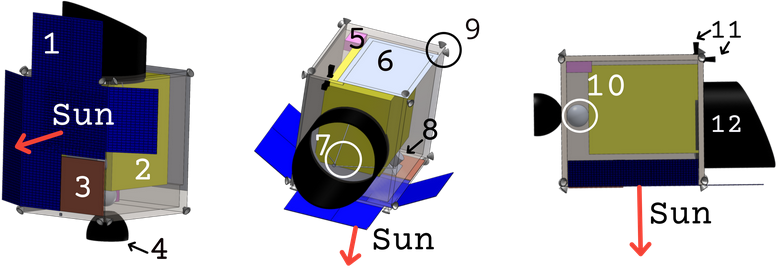Aetheras - L2 spectroscopy mission for characterisation of atmospheric escape
- 1Department of Electronics and Nanoengineering, Aalto University
- 2DTU Space, Department of Space Research and Technology, Technical University of Denmark
- 3Institut für Geophysik und Extraterrestrische Physik, TU Braunschweig
- 4Department of Earth Sciences, University of Lille
- 5Weltraumforschung und Planetologie, Physikalisches Institut, Universität Bern
- 6INAF-Osservatorio Astronomico di Roma
- 7Faculdade de Ciências da Universidade de Lisboa
- 8Institute of Theoretical Physics - Computational Physics, Graz University of Technology
- 9Faculty of Science, Technology and Medicine, University of Luxembourg
- 10Warsaw University of Technology
- 11Università di Bologna, Department of Industrial Engineering
- 12Department of Astrophysics, University of Vienna
- 13Uppsala University
- 14Mechanical and Aerospace Engineering University of Strathclyde
- 15Delft University of Technology, Faculty of Aerospace Engineering
- 16LATMOS/IPSL, UVSQ Université Paris-Saclay, Sorbonne Université, CNRS
Many exoplanets discovered so far exhibit distinct characteristics not observed within our own Solar System. With respect to planetary mass, orbital period, and radius, three categories are particularly interesting:
Hot Jupiters are gas giant exoplanets with an orbital period of less than 10 days and located closer than 0.1 AU from their host star. Especially magnetic fields have been expected in these bodies, but have not yet been detected unambiguously [Cauley et al. 2019, Trammell et al. 2011].
Sub-Neptunes are planets with a smaller radius than Neptune but near 2.0 RE (Earth radii). These planets have not been found to this day. The notable absence cannot be attributed to any discernible observational bias, thereby implying the influence of underlying processes such as
migration or atmospheric escape [Szabó et al. 2019].
Super-Earths are planets with a larger radius than Earth, yet lighter than ice giants. A distinct gap is discernible in the number of planets per star, specifically within the radius range of 1.5 RE to 2.0 RE . This so-called Radius Valley and the Hot Neptune Desert are still actively debated.
Plantes in the Radius Valley may represent an unstable region where planets transition towards a stable radius. Atmospheric escape could initiate this mechanism, including phenomena like photoevaporation [Zhang et al. 2023] and core-powered mass loss [Venturini et al. 2020]. Addressing these questions is crucial for advancing our understanding of exoplanetary systems.
The here proposed exoplanet mission, Aetheras, tries to address these questions in order to understand the formation of exoplanet systems by investigating atmospheric escape mechanisms andmeasuring proxies of magnetic fields. The mission focuses on objects in the Radius Valley and the Hot Neptune desert and tries to provide empirical evidence for the origins of these phenomena. Several 100 targets have been identified for investigation by cross-referencing different criteria for distance and planet radii with the NASA planetary archive.
Aetheras consist of a spacecraft using transit spectroscopy in the near-infrared range (1070 nm to 1090 nm) and ultraviolet range (115 nm to 285 nm) in an orbit outside the geocoronal influence (e.g. L2 Halo). The spacecraft has a weight of around 1500 kg and hosts two payloads which both use the same primary mirror of 1.5 m diameter.
With a proposed throughput of 12.96 % in UV and 34.01 % in IR the optical system is capable of capturing spectra with a resolution of 3724 and 571 respectively.
This system enables transit spectroscopy for several distinct absorption lines:
- H Ly-α 121.40 nm to 121.75 nm
- C II 130.00 nm to 137.00 nm
- Mg II 277.00 nm to 281.00 nm
- He I 1082.60 nm to 1084.00 nm
Especially the Ly-α line has been proposed as an indicator of atmospheric escape [Ehrenreich et al. 2015]. The other lines serve as additional proxies to be able to strengthen the results as well as adopt to several observation conditions [Dos Santos 2021]. Magnetic bow shocks can be also seen in exoplanet
spectroscopy [Llama et al. 2011] and present one method to probe planets for magnetic fields.

Figure 1: Spacecraft structure: 1 - solar panels, 2 - spectrometer, 3 - phased array antenna, 4 - orbital thruster, 5 - COM module, 6 - radiator, 7 - aperture, 8 - reaction wheels, 9 - RCS thrusters (x20), 10 - fuel tank, 11 - star tracker, 12 - baffle
Several studies have been made to understand the payload needs. These resulted in the here presented mission design proposal. A preliminary spacecraft has been outlined as seen in Figure 1 in addition to a data processing and ground station concept. With this, the Aetheras mission aims to be a helpful addition to the already existing instruments by focusing on exoplanet science only and providing more observation time and resolution to already existing targets as well as to new candidates once the Ariel mission is launched.
References:
[Trammell et al. 2011] ”Hot Jupiter Magnetospheres”, The Astrophysical Journal, DOI: 10.1088/0004-637X/728/2/152
[Cauley et al. 2019] ”Magnetic field strengths of hot Jupiters from signals of star–planet interactions”, Nature Astronomy, DOI: 10.1038/s41550-019-0840-x
[Szabó et al. 2019] ”The sub-Jupiter/Neptune desert of exoplanets: parameter dependent boundaries and implications on planet formation”, Monthly Notices of the Royal Astronomical Society: Letters, DOI: 10.1093/mnrasl/slz036
[Zhang et al. 2023] ”Detection of Atmospheric Escape from Four Young Mini-Neptunes”, The Astronomical Journal, DOI: 10.3847/1538-3881/aca75b
[Venturini et al. 2020] ”The nature of the radius valley-Hints from formation and evolution models”, Astronomy & Astrophysics, DOI: 10.1051/0004-6361/202039141
[Ehrenreich et al. 2015] ”A giant comet-like cloud of hydrogen escaping the warm Neptune-mass exoplanet GJ 436b”, Nature, DOI:10.1038/nature14501
[Dos Santos 2021] ”Atmospheric Escape In Exoplanets: A Journey From Gas Giants To Earth Twins”, DOI: 10.13097/archive-ouverte/unige:155240
[Llama et al. 2011] ”The shocking transit of WASP-12b: modelling the observed early ingress in the near-ultraviolet”, DOI: 10.1111/j.1745-3933.2011.01093.x
How to cite: Anger, M., Beltoft, A. S., Brecher, J. N., Corne, A., Egger, J. A., Filomeno, S., Graça, M., Keusch, V., Khairy, G., Kowalczyk, J., Lasagni Manghi, R., Loidolt, D. F., Marminge, M., McDougall-Page, A., Tamulevicius, L., Tonucci, E., and Wright Knutsen, E.: Aetheras - L2 spectroscopy mission for characterisation of atmospheric escape, Europlanet Science Congress 2024, Berlin, Germany, 8–13 Sep 2024, EPSC2024-222, https://doi.org/10.5194/epsc2024-222, 2024.